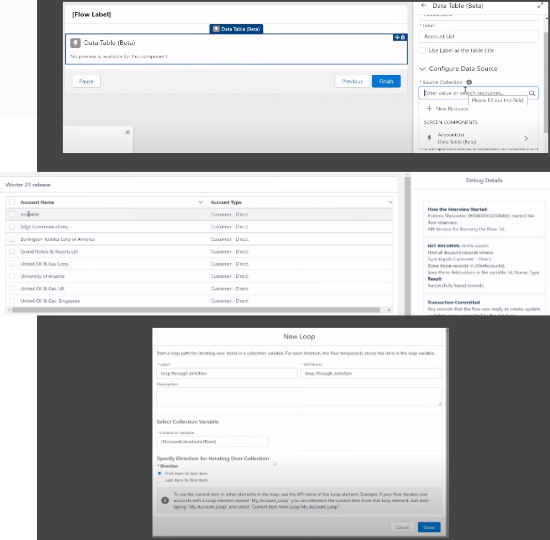The Salesforce Winter 2023 product release is here! This season’s release is chock full of new features and functionality. In fact, there are over 700 pages of release notes. If you’re a Salesforce admin and this sounds overwhelming, we get it. We narrowed down the list and came up with the top Salesforce updates.
1. Dynamic Forms are now available for standard objects
Prior to the Winter 2023 release, dynamic forms were only for non-standard objects and their lists could only have one filter. With the new release, you can not only use the powerful dynamic forms for Accounts, Contacts, Person Accounts, and Opportunities now, but you can also utilize multiple filters for their lists too.
Dynamic Forms lets Salesforce admins set visibility rules that show users only what they need to see. You can migrate the fields from your page layout into the Lightning App Builder where you can configure fields as individual components so your users see only the fields and sections they want.
Enhancements to Dynamic Forms also include:
- Simpler page layout management – manage fields in Lightning App Builder without having to touch the page layout editor.
- Break up record details – create flexible record pages for Accounts, including Person Accounts, Contacts, and Opportunities.
2. Changes in permissions
There are two significant changes in the features: User Access & Permissions Assistant and expiration of permissions.
User Access & Permissions Assistant
Salesforce added permission set enhancements that take us a step closer to ending the management of individual permissions in profiles by converting them to permission sets. With the newly revamped User Access & Permissions Assistant available on the AppExchange, you can see which permissions users have, how they got them, and visualize dependencies in permissions. Guest User Security will let you require granular flow permissions for any guest users.
Another big change is that permission sets can now have expiration dates. Note the expiration date circled in red below.
You can also set Field-Level Security for a Field on a Permission Set instead of through profiles during field creation. This can all be managed with the User Access and Permissions Assistant which reduces the number of manual steps needed to grant permission to a user.
3. Forecasting enhanced with custom fields for forecast filters
There are some big updates for how users engage with native forecasting in Salesforce. The enhancements to forecasting include:
- Added custom field types: Number, Currency, and Picklist
- Ability for sales managers and C-suite executives to filter by custom fields for their forecasts
- Quota attainment percentages are shown as progress bars in the summary view
- A single popup shows more information for forecast values that were adjusted and changed in the last 7 days
- The time period column is now frozen so you can keep your time frame point of reference when you scroll horizontally in summary view
- Improved visualization and navigation on the forecast page for Salesforce Desktop Site Forecasts.
- Added territory-based forecast types in the Salesforce Mobile App. Previously, you could view forecast types that were grouped by user role only. Now you can group by territory hierarchy.
4. Custom address
Custom address is a new field type and will help improve data accuracy. It functions the same way that standard address fields do. You can add custom addresses to any object except for Leads, Contacts, and Accounts. There’s even Google maps search and display functionality.
5. Automations
In the winter 2023 release, you’ll no longer see an option for creating new workflow rules. What you can do is move nodes around Flow Builder more easily with a new “cut” tool that allows you to move a node from one location to another–without having to change any API names.
Other automation enhancements include:
- ISCLONE function can now be used in Record-Triggered flow formulas when creating a clone
- Record-triggered flows can now update related records
- Months offset has been added to scheduled paths
Illustration of Data Tables in Flows below:

How these new automations help your business
These automations make it much easier to set up and deploy Intelligent Document Automation for Disclosures and Consent. There’s a new guided setup that walks admins through how to configure settings that control record sharing and the amount of information captured when gathering consent responses.
You can also automatically create payment schedules and payment schedule items to help out your account receivable department’s recurring payments. Once you configure the payment schedule to run, payments are collected automatically.
To help your sales people, features for Sales Engagement (previously called High Velocity Sales) grew to include customer engagement tracking, chatbots, and cadences. You now have access to everything you need to automate processes and help sales teams engage strategically with leads and customers.
Another benefit for sellers is a new automation to help add more intelligence to your flows when you add Targets to Cadences. The new Cadence Step Name can start a cadence target at any step in the cadence based on a field value or another condition.
For customer support, you can use automation in Omni-Channel Flows to route support cases to the right agents. Previously, this function didn’t allow for case routing unless you created a record-triggered flow. This comes in handy if your customers email their product questions in multiple languages. Your flow can route cases to agents with the language skills and product knowledge to assist.
It’s not just the useful features themselves but the skills of the administrator that enable a business to get the most value out of Salesforce. If you’re searching for the right person to add to your team, read the 7 steps for hiring Salesforce administrators.
Stay on top of Salesforce and other development by subscribing to our blog. You can also follow us on LinkedIn and Twitter.